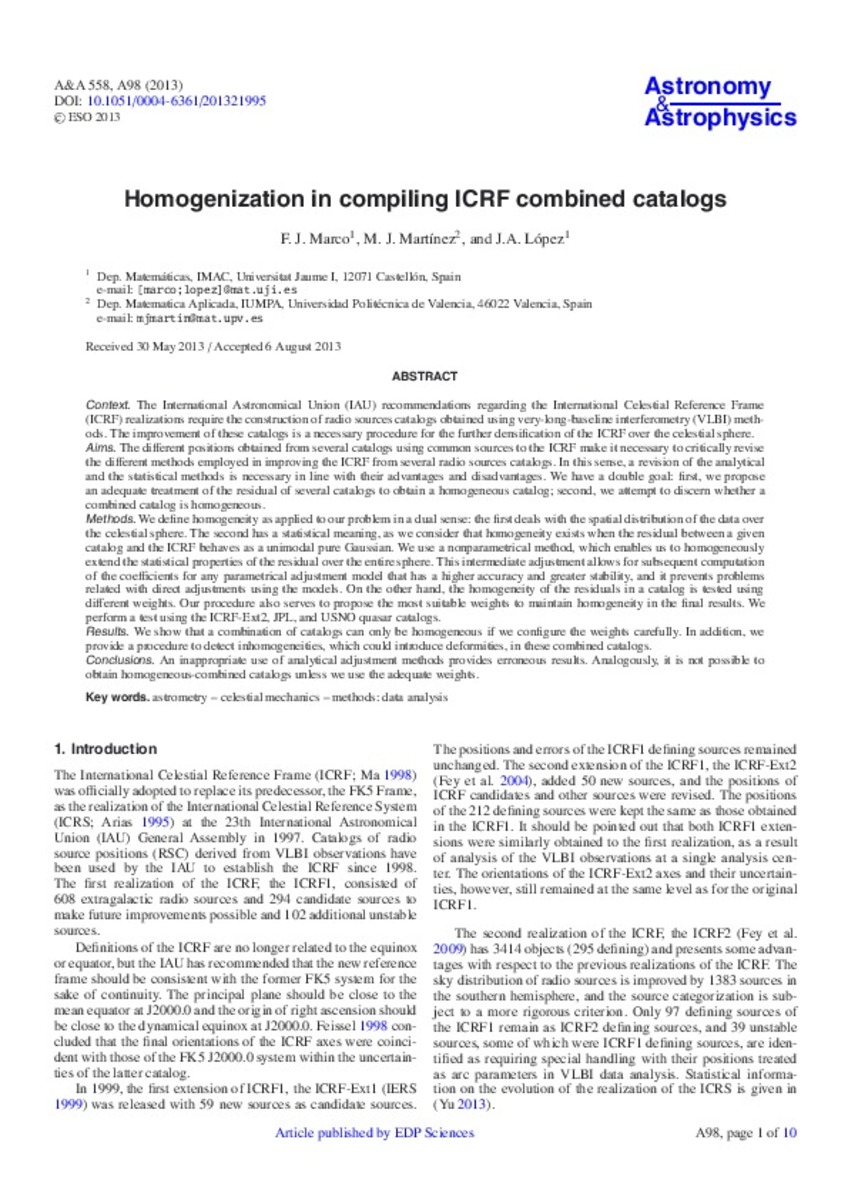Mostrar el registro sencillo del ítem
Homogenization in compiling ICRF combined catalogs
| dc.contributor.author | Marco Castillo, Francisco José | |
| dc.contributor.author | Martínez Usó, María José | |
| dc.contributor.author | López Ortí, José Antonio | |
| dc.date.accessioned | 2014-03-14T11:59:42Z | |
| dc.date.available | 2014-03-14T11:59:42Z | |
| dc.date.issued | 2013 | |
| dc.identifier.citation | Astronomy & Astrophysics, v. 558 (October 2013), p. A98, 1-10 | ca_CA |
| dc.identifier.uri | http://hdl.handle.net/10234/87251 | |
| dc.description.abstract | Context. The International Astronomical Union (IAU) recommendations regarding the International Celestial Reference Frame (ICRF) realizations require the construction of radio sources catalogs obtained using very-long-baseline interferometry (VLBI) meth- ods. The improvement of these catalogs is a necessary procedure for the further densification of the ICRF over the celestial sphere. Aims. The different positions obtained from several catalogs using common sources to the ICRF make it necessary to critically revise the different methods employed in improving the ICRF from several radio sources catalogs. In this sense, a revision of the analytical and the statistical methods is necessary in line with their advantages and disadvantages. We have a double goal: first, we propose an adequate treatment of the residual of several catalogs to obtain a homogeneous catalog; second, we attempt to discern whether a combined catalog is homogeneous. Methods. We define homogeneity as applied to our problem in a dual sense: the first deals with the spatial distribution of the data over the celestial sphere. The second has a statistical meaning, as we consider that homogeneity exists when the residual between a given catalog and the ICRF behaves as a unimodal pure Gaussian. We use a nonparametrical method, which enables us to homogeneously extend the statistical properties of the residual over the entire sphere. This intermediate adjustment allows for subsequent computation of the coefficients for any parametrical adjustment model that has a higher accuracy and greater stability, and it prevents problems related with direct adjustments using the models. On the other hand, the homogeneity of the residuals in a catalog is tested using different weights. Our procedure also serves to propose the most suitable weights to maintain homogeneity in the final results. We perform a test using the ICRF-Ext2, JPL, and USNO quasar catalogs. Results. We show that a combination of catalogs can only be homogeneous if we configure the weights carefully. In addition, we provide a procedure to detect inhomogeneities, which could introduce deformities, in these combined catalogs. Conclusions. An inappropriate use of analytical adjustment methods provides erroneous results. Analogously, it is not possible to obtain homogeneous-combined catalogs unless we use the adequate weights. | ca_CA |
| dc.format.extent | 10 p. | ca_CA |
| dc.format.mimetype | application/pdf | ca_CA |
| dc.language.iso | eng | ca_CA |
| dc.publisher | EDP Sciences | ca_CA |
| dc.rights | Attribution-NonCommercial-ShareAlike 4.0 Spain | * |
| dc.rights.uri | http://creativecommons.org/licenses/by-nc-sa/4.0/ | * |
| dc.subject | Astrometry | ca_CA |
| dc.subject | Celestial mechanics | ca_CA |
| dc.subject | Methods | ca_CA |
| dc.subject | Data analysis | ca_CA |
| dc.title | Homogenization in compiling ICRF combined catalogs | ca_CA |
| dc.type | info:eu-repo/semantics/article | ca_CA |
| dc.identifier.doi | http://dx.doi.org/10.1051/0004-6361/201321995 | |
| dc.rights.accessRights | info:eu-repo/semantics/openAccess | ca_CA |
| dc.relation.publisherVersion | http://www.aanda.org/articles/aa/abs/2013/10/aa21995-13/aa21995-13.html | ca_CA |
| dc.type.version | info:eu-repo/semantics/publishedVersion |
Ficheros en el ítem
Este ítem aparece en la(s) siguiente(s) colección(ones)
-
MAT_Articles [747]
Articles de publicacions periòdiques








